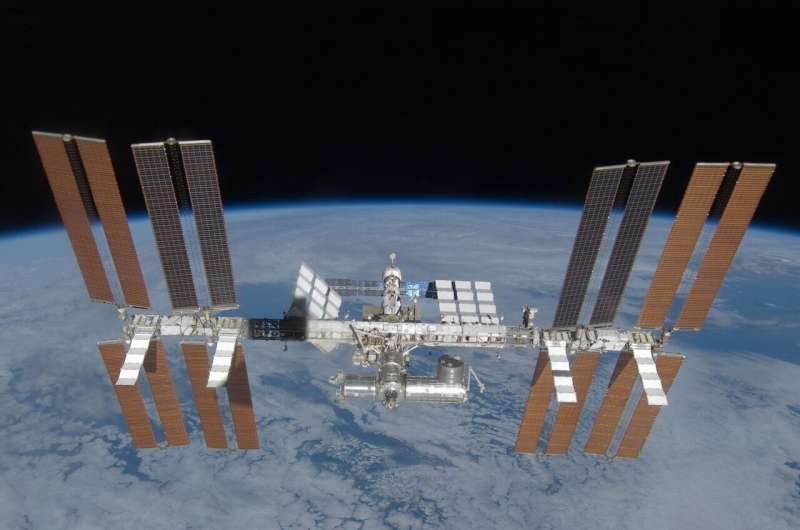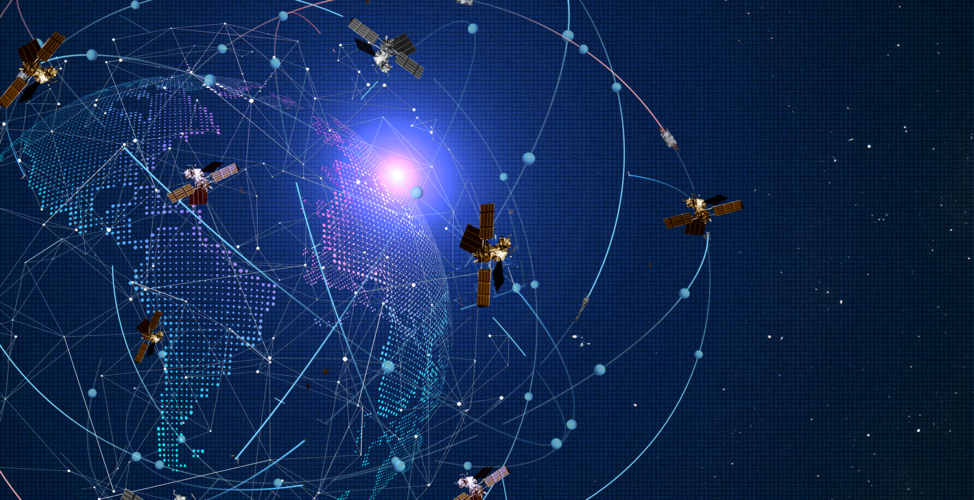Parker Solar Probe Achieves 20th Close Encounter with the Sun
Monday, 08 July 2024 16:09 NASA's Parker Solar Probe successfully made its 20th close approach to the Sun on June 30, 2024. The probe came within 4.51 million miles (7.26 million kilometers) of the Sun's surface, equaling its previous distance record.
"The close approach (known as perihelion) occurred at 3:47 UTC (11:47 p.m. EDT on June 29), with Parker Solar Probe moving 394,736 miles per hour (635,266 kilometers p
NASA's Parker Solar Probe successfully made its 20th close approach to the Sun on June 30, 2024. The probe came within 4.51 million miles (7.26 million kilometers) of the Sun's surface, equaling its previous distance record.
"The close approach (known as perihelion) occurred at 3:47 UTC (11:47 p.m. EDT on June 29), with Parker Solar Probe moving 394,736 miles per hour (635,266 kilometers p Milky Way's Warp Reveals Shape of Dark Matter Halo
Monday, 08 July 2024 16:09 A research team led by Dr. HUANG Yang from the National Astronomical Observatories of the Chinese Academy of Sciences (NAOC) has developed a novel "motion picture" method for measuring the precession rate of the Milky Way's disk warp. Utilizing this innovative approach, the team observed the precession direction and rate of the Milky Way's warp using a sample of Cepheid variable stars of various
A research team led by Dr. HUANG Yang from the National Astronomical Observatories of the Chinese Academy of Sciences (NAOC) has developed a novel "motion picture" method for measuring the precession rate of the Milky Way's disk warp. Utilizing this innovative approach, the team observed the precession direction and rate of the Milky Way's warp using a sample of Cepheid variable stars of various Quantum Detectors Poised to Reveal Dark Matter Mysteries
Monday, 08 July 2024 16:09 A major scientific enigma may be closer to resolution as researchers harness cutting-edge quantum technology.
Approximately 80% of the universe's matter is dark, eluding direct observation but detectable through its gravitational effects. Despite ongoing efforts, these dark matter particles remain unseen.
Scientists from Lancaster University, the University of Oxford, and Royal Hollo
A major scientific enigma may be closer to resolution as researchers harness cutting-edge quantum technology.
Approximately 80% of the universe's matter is dark, eluding direct observation but detectable through its gravitational effects. Despite ongoing efforts, these dark matter particles remain unseen.
Scientists from Lancaster University, the University of Oxford, and Royal Hollo NASA's CURIE CubeSat to Study Space Weather on Ariane 6 Rocket
Monday, 08 July 2024 16:09 NASA's CURIE (CubeSat Radio Interferometry Experiment) will be a rideshare payload on the ESA's (European Space Agency) first flight of the Arianespace Ariane 6 rocket, aimed at exploring the main factors influencing space weather. The launch is scheduled for July 9 from Europe's Spaceport, the Guiana Space Center in Kourou, French Guiana.
Designed by Dr. David Sundkvist and his team at th
NASA's CURIE (CubeSat Radio Interferometry Experiment) will be a rideshare payload on the ESA's (European Space Agency) first flight of the Arianespace Ariane 6 rocket, aimed at exploring the main factors influencing space weather. The launch is scheduled for July 9 from Europe's Spaceport, the Guiana Space Center in Kourou, French Guiana.
Designed by Dr. David Sundkvist and his team at th RuggON's Vehicle-Mounted Computer Offers Global Connectivity
Monday, 08 July 2024 16:09 RuggON, a leading provider of rugged computing solutions, has unveiled the Iridium Connected VORTEX, a robust Vehicle-Mounted Computer (VMC) designed for seamless global connectivity. Equipped with a specialized antenna and an integrated satellite-communications module, the Vortex ensures reliable data and message exchange even in the most isolated locations, beyond the reach of conventional 5G
RuggON, a leading provider of rugged computing solutions, has unveiled the Iridium Connected VORTEX, a robust Vehicle-Mounted Computer (VMC) designed for seamless global connectivity. Equipped with a specialized antenna and an integrated satellite-communications module, the Vortex ensures reliable data and message exchange even in the most isolated locations, beyond the reach of conventional 5G Ovzon 3 Satellite Commences Commercial Service
Monday, 08 July 2024 16:09 As previously communicated, Ovzon's proprietary satellite, Ovzon 3, has reached its designated position in the geostationary arc. After several weeks of final in-orbit testing, the satellite is now ready for commercial service.
The first delivery of SATCOM-as-a-Service from Ovzon 3 will be provided to the French government organization GIGN (Groupe d'Intervention de la Gendarmerie National
As previously communicated, Ovzon's proprietary satellite, Ovzon 3, has reached its designated position in the geostationary arc. After several weeks of final in-orbit testing, the satellite is now ready for commercial service.
The first delivery of SATCOM-as-a-Service from Ovzon 3 will be provided to the French government organization GIGN (Groupe d'Intervention de la Gendarmerie National Effects of Visual and Auditory Guidance on Space Station Tasks
Monday, 08 July 2024 16:09 Researchers from the Beijing Institute of Technology conducted a study examining the impact of visual and auditory instructions on procedural tasks within a simulated space station environment. The study involved 30 participants (15 men and 15 women) aged between 20 and 50, with an average age of 42. All participants were right-handed and free from significant visual or auditory impairments, mee
Researchers from the Beijing Institute of Technology conducted a study examining the impact of visual and auditory instructions on procedural tasks within a simulated space station environment. The study involved 30 participants (15 men and 15 women) aged between 20 and 50, with an average age of 42. All participants were right-handed and free from significant visual or auditory impairments, mee Shenzhou XVII Crew Shares Post-Mission Insights with Media
Monday, 08 July 2024 16:09 The astronauts of China's Shenzhou XVII mission held their first press conference on Friday, two months after returning from their space expedition.
The three crew members - Tang Hongbo, Tang Shengjie, and Jiang Xinlin - are reported to be in excellent physical and mental condition. Their muscle strength, endurance, and cardiopulmonary function have largely returned to pre-flight levels.
The astronauts of China's Shenzhou XVII mission held their first press conference on Friday, two months after returning from their space expedition.
The three crew members - Tang Hongbo, Tang Shengjie, and Jiang Xinlin - are reported to be in excellent physical and mental condition. Their muscle strength, endurance, and cardiopulmonary function have largely returned to pre-flight levels. The Young Professional Satellite - From Theory to Reality (episode 2)
Monday, 08 July 2024 13:00 Video:
00:14:53
Video:
00:14:53
In the second episode of this docu series, we take a closer look into what it took to build ESA’s Young Professional Satellite (YPSat). YPSat’s mission objectives are to capture the key moments of Ariane 6’s inaugural flight and take in-orbit pictures of Earth and space. To achieve this, the satellite requires the multiple sub-systems to work in harmony and adhere to a pre-defined mission sequence.
This episode zooms in four of the sub-systems: the Wake-Up System (WUS), Battery, On-Board Computer (OBC) and Telecommunications.
Running at ultra low power, the WUS circuit board was designed, tested and manufactured specifically
NASA astronauts spend unexpected July 4 on the International Space Station
Monday, 08 July 2024 12:10
Astronauts Suni Williams and Butch Wilmore spent an unexpected Fourth of July aboard the International Space Station—but it was hardly a patriotic display of engineering prowess.
The two NASA astronauts docked with the orbiting lab June 6 for what was supposed to be an eight-day mission, but their return home may be delayed for months in what has become a star-crossed test flight for Boeing's new Starliner capsule.
Not only was the launch of the spacecraft with astronauts aboard for the first time repeatedly delayed because of multiple problems, but NASA and Boeing are taking a cautious approach in returning the pair to Earth largely because of five thrusters that malfunctioned during docking.
Four of the tiny engines that direct the craft in space are now working properly, but engineers don't have a clear understanding of what caused the shutdown, so they have decided to conduct ground tests at NASA's White Sands Test Facility in New Mexico, NASA officials said. The tests will put a Starliner thruster through its paces in a replicated space environment.
The delay also will allow engineers to further study a helium leak in the capsule's propulsion system that was first detected before launch and worsened as Starliner made its way up to the space station roughly 250 miles above Earth.
Highlights from ESA’s first open day in the UK
Monday, 08 July 2024 12:00 Video:
00:02:54
Video:
00:02:54
On Saturday 29 June, thousands of visitors made their way to ESA’s European Centre for Space Applications and Telecommunications (ECSAT), as part of the very first ESA open day to be held in the UK.
ECSAT is located at the Harwell Science and Innovation Campus in Oxfordshire and the ESA open day formed part of the campus-wide Harwell open week.
The open day, hosted by ESA’s Magali Vaissiere Conference Centre, featured fascinating talks and activities that enabled people to experience first-hand how ESA is pushing the boundaries of exploration and using space to improve life on Earth. It also showcased the many career
Military-to-civilian space traffic transition nears critical juncture
Monday, 08 July 2024 12:00
Call for ideas on navigation demonstrators and technologies
Monday, 08 July 2024 11:13
Do you want to help shape the future of European satellite navigation? ESA is issuing an open call via OSIP for companies and researchers to help identify future navigation demonstrators and disruptive technologies that will shape the landscape of satellite navigation in the coming decades.





